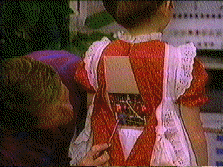

 When Howard Leeds conceived of Vicki, he'd been exposed to the video games and
primitive robots of the early '80s and correctly assumed that as advanced as
domestic robots might become, they wouldn't be welcome into homes until they no
longer resembled metal-armed vacuum cleaners and spiders. Intimately keen of
Hollywood special effects houses and audioanimatronics, Leeds knew that creating
Vicki's body wasn't that difficult, nor creating lifelike latex face masks real
enough to pass casual scrutiny. He reasoned that if Hollywood could create a
close enough physical approximation of Vicki's body, what could the corporate
resources of the country (United Robotronics) create? It turns out surprisingly
close to the faithful first-season depiction of Vicki. For a deeper view into the
technical details, read the "Vicki on
Dunahue" parody.
When Howard Leeds conceived of Vicki, he'd been exposed to the video games and
primitive robots of the early '80s and correctly assumed that as advanced as
domestic robots might become, they wouldn't be welcome into homes until they no
longer resembled metal-armed vacuum cleaners and spiders. Intimately keen of
Hollywood special effects houses and audioanimatronics, Leeds knew that creating
Vicki's body wasn't that difficult, nor creating lifelike latex face masks real
enough to pass casual scrutiny. He reasoned that if Hollywood could create a
close enough physical approximation of Vicki's body, what could the corporate
resources of the country (United Robotronics) create? It turns out surprisingly
close to the faithful first-season depiction of Vicki. For a deeper view into the
technical details, read the "Vicki on
Dunahue" parody.
Technical consultants for the show, armed with speculative marketing research for venture capitalists, concurred with Leeds that there's an overwhelming general perference for anthropomorphic robots in the home environment, and the prime attraction is perceived family friendliness. Though intriged, Leeds, not desiring a live-action "Jetsons", wanted to know what was possible with State-of-the-art (1980's) technology in android design with unlimited funds to increase the credibility of his robot in a contemporary sitcom. This was no minor point if one compares the show with Disney's blatant 1987 rip-off Not Quite Human, whose android teen brother exhibits near-human reasoning powers and emotional facilities in today's world as opposed Vicki's near-faithful rendition of what's actually possible in current artificial intelligence. Vicki's basically stoic effect was accurate, but it'd also exact a histronic price on the actress.
Most androids and robots of fiction are anachronistic, displaying capabilities far in excess of the technology of the time. Vicki was intended to portray the kind of android-robot possible in the 1980s under a "Project Apollo" effort: a robot that was mobile, had optical and voice recognition, and had manual dexterity. Season one's Vicki portrayal was very close to this prediction by story technical advisors from nearby Stanford and CalTech, except for two factors: It was felt that IC technology still wouldn't be sufficient to condense the visual processing computers and their memory within the size of a child's skull before the year 2000, and it was suggested that Vicki's CPU be a Cray at Ted's office linked by radio to her "body" instead. It was seriously considered and dumped mostly from, as the producers said, its "ghoulish" disembodied-brain overtones. The surviving spin-off of this concept was Ted's terminal in the living room into which he periodically downloads her daily memories and which saves her in "Class Comedienne."
In the pilot, the production originally wanted to rent an ex-Disney Alice in Wonderland audioanimatronic robot from a special effects house as a disassembled Vicki, but prohibitive costs forced the producers to make do with an unconvincing store mannikin. There are also notable technical foibles that fan mail techies correct very early on, such as Ted's reference that Vicki's eyes are solar cells; by "The Wedding" it's properly defined that her optics use charge-coupled photoreceptors, and in "Jamie's Older Woman" that she is powered by an RTG, or RadioThermonic Generator similar to power packs on nuclear pacemakers, space probes and polar monitors. Making Vicki nuclear-powered was a bold logical assertion when being anti-nuclear on TV was very politically correct.